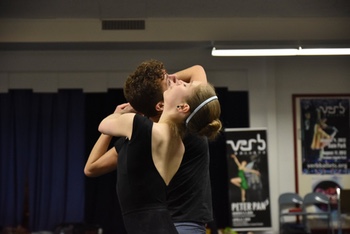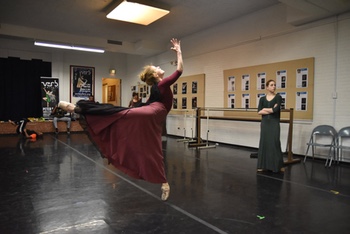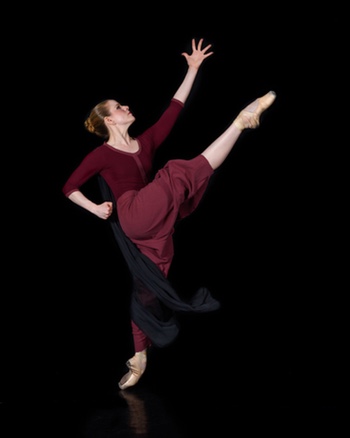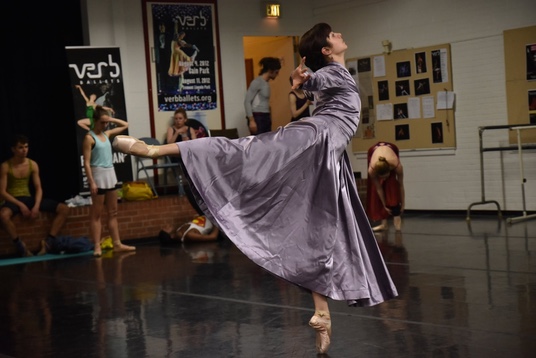Fri 2/19 @ 8PM
Heinz Poll and Tom Skelton brought professional ballet to the Akron area. Ohio Ballet, the company they founded together in 1968, preceded Cleveland Ballet and outlasted that larger, wealthier company by six years. Since the ’60s, many things have changed for the better. Dance is now widely recognized as a profession in northeast Ohio, and facilities for the study and performance of dance have greatly improved. Like seeds cast from a prolific garden, Poll’s Ohio Ballet alumni have fanned out over our region, cultivating a lasting legacy.
Verb Ballets brings a Heinz Poll tribute to Akron Civic Theatre this coming Friday, a program built around three of Poll’s ensemble pieces, Elegiac Song, Songs Without Words and Bolero. Researching a preview, we spoke on the phone with Lana Carroll Heylock and Jane Startzman, two who danced for Poll from his earliest days in Akron. In a third phone interview, Margaret Carlson, producing artistic director of Verb Ballets, drew on her deep familiarity with the Poll legacy to further describe the concert. For this article, we’ve combined the three separate phone conversations into a virtual round table discussion.
CoolCleveland: Dr. Carlson, Margaret, please go first. Tell our readers about Elegiac Song.
Margaret Carlson: Our plan is to present the three group dances in the order in which they were created so you can see where Heinz started and where he ended. Elegiac Song was the first dance he choreographed for Chamber Ballet, the student group that later became Ohio Ballet. Bolero was – pretty much – the last. It’s easier to understand where Elegiac Song came from if we remember that Heinz began studying dance shortly after the end of World War II at the Folkwang School where Kurt Jooss, who choreographed Green Table (1932) and other works, was a major influence. Then when Heinz left Germany he ended up in the National Ballet of Chile where Jooss was also an enormous influence.
CC: So Heinz got a double dose of the Kurt Jooss aesthetic.
Carlson: Yes, and Elegiac Song resembles Green Table in that it’s about the impact of war, in this case on the women who are left behind while their men are off on the battlefield. When it was first performed, Elegiac Song was all women. Later Heinz added a male role, a soldier who briefly sees his loved one and then goes off to war.
CC: What about the Graham technique in Elegiac Song?
Carlson: There is a great deal of contraction work. That’s how he conveys the sense of loss. And they do a series of grand jetés in contraction which is very difficult. But there were no hard lines to generating movement. There was a lot of choreographic exploration going on in the 20th century.
CC: Grand jetés from ballet. Contractions from Graham. It shows how eclectic Heinz was back in a time when there was still antagonism between ballet and modern dance. But Elegiac Song also reminds us of how committed he was to the aesthetic outlook of German modern dance, what’s now known as tanztheater, which emphasized meaning and serious programmatic content rather than art-for-arts-sake.

CC: What about you, associate professor Heylock, Lana. Were you in the first Chamber Ballet concert in October of 1968 in Kolbe Hall? The one with Elegiac Song, Rossiniana, and — what? — Micro Concerto?
Heylock: Yes, that was the first program. I was one of the war women in Elegiac Song.
CC: Let’s take our focus off of the actual choreography for a moment and give our readers an idea what dance facilities were like back then. Where were rehearsals for that first concert held?
Heylock: Like a lot of the early classes, I think rehearsals were in Memorial Hall, both in the big gym and downstairs in a little studio that — I think — doubled as a judo studio. Those were the classrooms that were used for a couple of summer sessions. And then there was that little building …
CC: Do you remember that little white clapboard building, the former church where they had classes for a while?
Heylock: Yes, I guess it was a church. It was on James Street, which is now something else, and the new university building for dance, Guzzetta Hall, right near what’s now EJ Thomas Hall, is on the exact same soil.
CC: Spooky. So, unlike the excellent studios in Guzzetta, the facilities for Chamber Ballet in 1968 were makeshift, but in Heinz Poll’s autobiography, A Time to Dance, he says his first teaching gig in Akron was even more makeshift, one week in 1966 in a basement studio.
Heylock: Yes, I took those classes. My first training was with Nan Klinger, and when she brought Heinz to the Akron area, the first place he taught was her studio, the basement of her house on Byrd Avenue.
CC: Concrete floors, right?
Heylock: I believe so. And, you know, rehearsing Elegiac Song he was a purist, he wanted it clean and precise. He was dead set on having a professional dance company, making this group of teenagers that he had into a professional company. So in many ways the seriousness, the idea of what is professional — we all learned that very early on. It was really hard work and there was no time for anything else. None of us went to prom, to football games. None of us had any of that.
CC: The music for Elegiac Song is Dimitri Shostakovich’s String Quartet No. 8 or at least that’s what the music is now. But Poll acknowledges in his biography that he changed Elegiac Song a lot over the years and so we wonder if that first performance in 1968 used all five movements and 20 minutes of that music.
Heylock: I think each piece was about 20 minutes to a half an hour long so it may have been. Elegiac Song is a wonderful piece, very powerful, and he took such pains, revising and reworking it for years after the premiere.
CC: The thing I remember was the importance of Skelton’s lighting. There’s an overall mood of sadness set by the dancing and the music but during a crisis in the music a red glow came from offstage. Given the original intent of that music, which was part of a project about the fire-bombing of Dresden, we clearly understand that the soloist looking offstage at that glow is seeing the cataclysmic destruction of Dresden. To me that’s very powerful if the audience is aware of the association between that music and the event.
Heylock: For us it was more of a universal statement about war and people dying. And these lonely women. And putting on the veils. The feeling that we’ve lost people.
CC: What was the attitude toward ballet in the Akron and Cleveland area back in 1968? The community was pretty much clueless about ballet, correct?
Heylock: It’s so hard for me to answer “What was society like?” because I saw it from a child’s view. I went to school and then I’d go to ballet class or rehearsal. I feel like a lot of the plans made between Heinz and Tom Skelton were made over my parents’ dining room table. When guest artists would come, I believe that they were usually Tom’s contacts because he was a world-renowned lighting designer for Broadway as well as for dance. So, when you ask, “How did Ohio Ballet — this new, small company — have those outrageous guest artists, how did Ohio Ballet have those contacts?” Well, Tom was the lighting designer for Joffrey Ballet and so we got Robert Joffrey and Gerald Arpino to set pieces on us. Tom was lighting designer for Paul Taylor so, yeah, Paul Taylor was there and my brother as a teenager was dancing Paul’s solo from Aureole.
Anyway, Tom was a great conduit for all the stars that came through and worked with the dancers. But about societal attitudes toward ballet I really can’t say. To me it was normal to have George Balanchine in our backyard, our garden, talking about flowers with my father in Russian and then sitting down to dinner. Not that big of a deal.

CC: You sat down to dinner with Balanchine? We knew that Ohio Ballet had some Balanchine repertoire, Concerto Barocco and Allegro Brillante, but we assumed Balanchine would have sent one of his rehearsal directors to set those pieces.
Heylock: New York City Ballet used to come every summer to perform at Blossom. I don’t even know if Balanchine was at our house because of Tom and Heinz, because of my mother’s various affiliations with Ohio Ballet — associate artistic director and later executive artistic director — or simply because my parents were Russian. But that was my growing up. I knew they were special but now I think, OMG, these were the trailblazers of dance sitting around the dining table and there I was, 12 years old eating my chicken soup.
CC: Do you remember anything about community reaction to Heinz’ relationship with Tom Skelton, Heinz and Tom openly living together during those homophobic times?
Heylock: No. Not really. It was part of my norm. Maybe my parents heard something but no one ever said anything to me or teased me about it. You have to remember that Heinz and Tom were kind of celebrities. Some people might have been naïve and others may not have cared.
CC: Thanks for painting that picture of 1968, Lana. We can’t appreciate what Heinz accomplished without remembering what things were like back then. Let’s go on to talk about Songs Without Words, Margaret.
Carlson: Songs Without Words is also a war piece. Like Elegiac Song, it’s only been performed one season since Heinz’ death; we performed them in — I think — 2005. Songs Without Words is a beautifully constructed retrograde piece. It starts off with a huddle of a group of Jewish people of various ages and types. They are moments away from the gas chambers with their backs to the audience. That tableau goes on for such a very long time that I initially wondered why he did it like that — people don’t have much of an attention span these days — but I’ve come to think that it allows your eye to see each character’s body language, to let it sink in.
Then the piece turns into a series of solos, duets and trios in which each character is explored for who they were. A young couple very much in love. An older, aristocratic Jewish couple in which the husband is having an affair with a German girl. Is he doing it to save his own skin? To push away his Jewish roots? The tragedy is seen in the aristocratic wife, who is watching with an awareness that it’s not just their marriage at stake, that it’s about the destruction of the Jewish people in Germany. And there’s a solo, a partisan, a male character who’s fighting. At the very end of the ballet it flashes back to the group we saw at the beginning just as the shroud, the gas, comes down on them.
CC: So Jane, you were there when Heinz first set Songs Without Words.
Starzman: Yes. I was in the original cast.
CC: And you’ve already mentioned how he talked to you about that dance. He didn’t just give you the steps and then correct technical details.
Starzman: He talked to us a lot about both Songs Without Words and Elegiac Song. I danced several roles in that piece as well. His explanations were even more necessary in Elegiac Song because we were so much younger when he choreographed that one. At least when he choreographed Songs Without Words we were old enough to have read about the Holocaust.
Whenever he did any of his dramatic ballets he constantly talked to us about how the movement needed to be. How, if we stood in the middle of the stage and wept melodramatically, the audience might feel sympathy but we’d never capture their hearts. Whereas if we used movement — how you stand, which way you face, how you use your hands — we could make the audience understand the pain. It’s true, and it speaks to choreographers and dancers finding effective movement rather than mugging, which is never effective.

CC: It’s always nice when the artist gives the audience credit for being observant.
Starzman: Keep an eye on the movement and the choreography in terms of telling a story as opposed to looking for the obvious.
CC: I just wanted to add something about the two World War II pieces. Heinz describes his wartime experiences in considerable detail in his memoir, but he was succinct and candid in a one-on-one conversation we had at EJ Thomas shortly before his retirement. He said, “If you want to know what I did during the war, go see the movie Swing Kids, because I was one of those kids.” Asked about his experience on the Eastern Front, he said, “You lived every day in a state of absolute terror, because everyone you know has been killed or may be killed soon.”
So, the two World War II pieces, then Bolero.
Carlson: Heinz choreographed Bolero after the Ohio Ballet’s tour in India. He fused elements of Indian dance with the Ravel music.
CC: Bolero’s a wonderful music visualization. And mention of the Indian tour reminds us of all the national and international touring Ohio Ballet did.
Starzman: Yes, nationwide including New York City. Internationally to Italy and India. When we toured South America, people asked all the time for Heinz Poll. He really was widely known and respected there.
CC: South America was where Heinz started doing the free public performances for Chilean miners and their families.
Starzman: The dancers would go out into the hills, into little villages where the Indians lived. Really primitive conditions and it was unlikely that such poor people would ever be able to afford a ticket to the ballet, but Heinz said that the wonder in people’s faces when they saw dance in their own back yard really impressed him. Later people objected to taking free performances into Akron area parks, saying that “If you give it away, no one will pay for a ticket.” Heinz’ response was that the point is to give the arts as a gift. I think he was ahead of his time. After 40-some years of free performances we have generations of people who have come to the Heinz Poll Summer Dance Festival.
CC: It’s still pretty much unique. And it’s seldom as well run as it is in Northeast Ohio.
Starzman: I hope and pray that it continues. Of course the most fragile aspect of the outdoor performances is the funding. The City of Akron has been picking up the tab, even when the economy tanked, and that is extremely unusual. Our city values the legacy of that festival, and that says a lot.
CC: And what else are you doing, Margaret? Isn’t there a pas de deux in the program?
Carlson: Yes, we’re doing Duet. It’s the only piece that we’re performing out of sequence, right after Elegiac Song. Duet has been in our repertoire for many, many years. With just two people, leotards and tights, about eight minutes long, it’s a very good piece to round out a program.
CC: Oh, yes. Duet is that pas de deux that Verb performs in black and white. I like it because it shows that Heinz could choreograph a neoclassical piece when he wanted to. And I believe you mentioned a film?
Carlson: Yes, we’re planning to show the documentary that I was producing when Heinz was in his final month. He gave me access to his personal belongings, his DVDs, his books and photo albums. So I put together a documentary about 15 minutes long. I was quite honored that he gave me all that access.
CC: We understand that Verb has just returned from performances in New York.
Carlson: Yes, we performed at the Martha Graham Dance Company facilities in Westbeth, which used to be Merce Cunningham’s facility. It’s got that studio theater which is actually a step above a black box with ample lighting and a huge performing space. Artistic director Janet Eilber introduced us and explained what the Lamentation Project was. It was a great experience. The Graham people could not have been more accommodating; they were easy to get along with and very professional. The audience reaction was stupendous; it was standing room only and we got a standing ovation. Every aspect of the experience exceeded my expectations. We’re very grateful to the John P. Murphy Foundation, whose grant picked up the lion’s share of the costs.
CC: So glad that went well for Verb. New York audiences can be tough.
Verb Ballets performs a tribute to Heinz Poll at Akron Civic Theatre Fri 2/19 @ 8pm. Single tickets are $22-$32; $12 for students. Call the Akron Civic Box Office at 330-253-2488 or go online at akroncivic.com. For more information visit verbballets.org.
[Written by Elsa Johnson and Victor Lucas] [Photos by Mark Horning]
